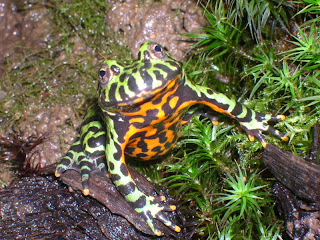 |
| Bombina orientalis |
On any normal viewing, the Fire-bellied Toad will appear green with a black mottle pattern. However, once they are threatened they will rise on their hind legs and present their smooth, bright red and black underside to the predator, sometimes doing a near back-flip in the process! The red color warns against the dangerous toxin that the Toad secretes from its skin.
Oriental Fire-bellied Toads are very common throughout most of their range, and they are also kept as pets in captivity. They are very hardy, require only a 10 gallon aquarium, are considered to be suitable for beginning Frog keepers, and can live ten years or more!
IUCN Status : Least Concern
Location : East Asia
Size : Length 2in (5.5cm)
Size : Length 2in (5.5cm)
Classification : Phylum : Chordata -- Class : Amphibia -- Order : Anura
Family : Bombinatoridae -- Genus : Bombina -- Species : B. orientalis
Family : Bombinatoridae -- Genus : Bombina -- Species : B. orientalis
Comments
Post a Comment